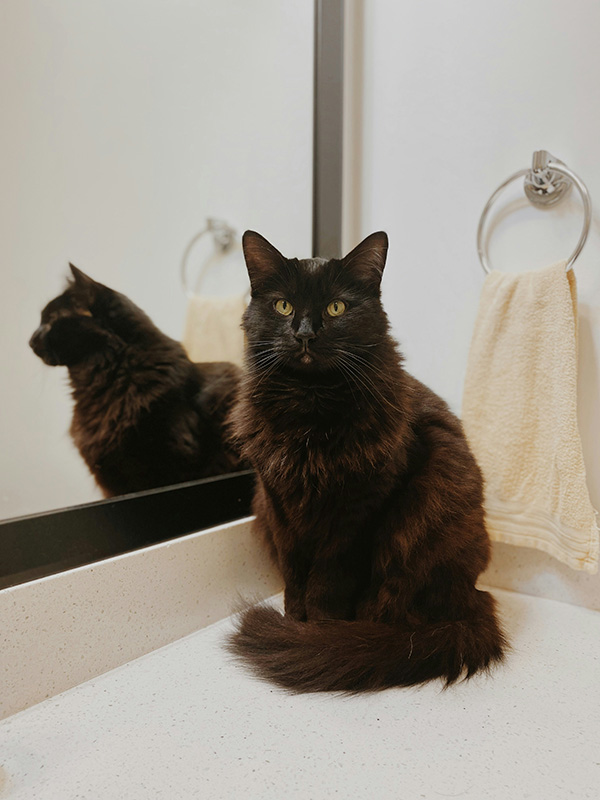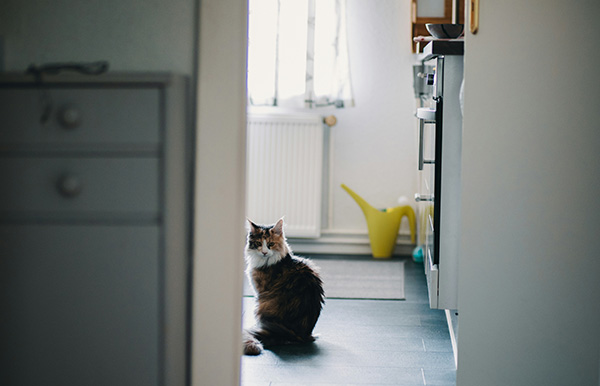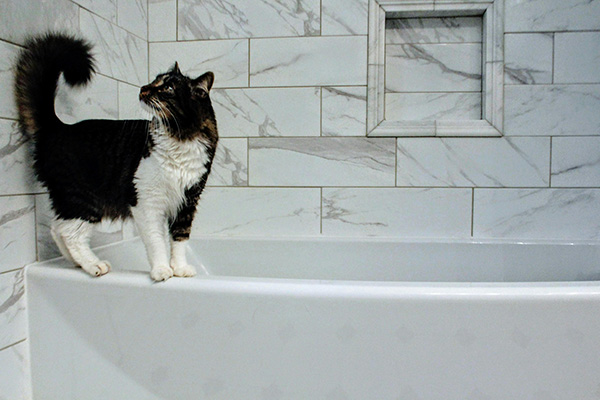For many cat owners, seeing their feline companion following them into the bathroom is both amusing and baffling. You're not the only one curious about why your cat insists on being with you during these private moments. This behavior, while odd at first glance, is quite common among cats and can be attributed to various reasons.
From their strong bond with you and curiosity about your activities to their natural instincts and need for security, vets and cat behaviorists have several reasons why your cat keeps you company in the bathroom. Understanding these reasons can help you appreciate this quirky behavior as another way your cat expresses affection and interest in your life.
6 Reasons Cats Follow You To The Bathroom
Companionship and Bonding

One common reason cats follow their owners to the bathroom is to spend time with you and have your undivided attention. This behavior often shows your cat's trust and affection, as they choose to be near you during vulnerable moments. Even though cats prefer privacy when using their litter box, they want to provide companionship while you do yours. Many cats only want to sit next to you, while other cats want to sit in your lap and demand attention.
Just remember, cats love and value their bond with their owners and may follow them to maintain closeness and comfort. To recognize if this is the cause, look for other signs of affection your cat may display, such as purring, rubbing against your legs, or a relaxed demeanor when in your presence.
To foster this bonding behavior, spend quality time with your cat each day, engaging in activities they enjoy, such as playing with toys or gentle petting. Creating a welcoming atmosphere in the bathroom, like placing a small cat bed or a comfortable mat, can also make these moments more enjoyable for your cat. This reinforces the bond and satisfies your cat's need for companionship in a positive and reassuring way.
Curiosity and Interest in Routine
Cats are naturally curious creatures, and this trait often extends to an interest in their owner's routines, including following them into the bathroom. This behavior may stem from a desire to understand and participate in everything you do.
To discern if curiosity and interest in your routine are the reasons, observe whether your cat shows heightened alertness or engagement when you change your usual activities or if they seem particularly fascinated by bathroom fixtures like running water or flushing toilets.
Addressing this curiosity constructively involves providing alternative activities that satisfy their investigative nature. You can introduce new toys that mimic some bathroom features, like water fountains for pets, or schedule regular interactive play sessions that engage their senses. This helps divert their curiosity to more appropriate outlets and reduces their need to follow you into the bathroom.
Territorial Behavior

Cats are inherently territorial animals, and your home is considered your cat's territory. Cats' behavior often reflects their need to oversee and control their environment, including following you into the bathroom.
If your cat demonstrates territorial behavior, you might notice it marking the bathroom with its scent by rubbing against the walls or furniture, or it may seem particularly vigilant while in space. This behavior can intensify in multi-pet households, where the presence of other animals might make it feel the need to reaffirm its dominance or claim over certain areas, including where you spend a good amount of time.
To manage territorial behavior effectively, animal behaviorists recommend providing multiple designated spaces where your cat can feel in control throughout your home. Use pheromone diffusers to help ease territorial stress and maintain a calm environment. Encouraging the use of these spaces with treats and positive reinforcement can help divert their need to follow you into the bathroom.
Additionally, maintaining a routine that includes dedicated play and interaction times can reassure your cat of their valued place in the household hierarchy, reducing the need to assert dominance in less appropriate ways, like following you into the bathroom.
Seeking Attention and Comfort
When your healthy cat follows you to the bathroom, it's often a sign that they seek attention and comfort. This behavior is particularly common in cats who share a close bond with their owners or feel insecure and seek reassurance. Signs that your cat seeks attention and comfort include meowing, pawing at you, or persistent rubbing against your legs once you're in the bathroom. They might also become unusually clingy, following you closely around the house.
To address your cat’s need for attention and comfort, ensure that you spend dedicated time each day engaging with them through play, petting, or even talking to them. Creating a welcoming environment in other parts of the home, like setting up cozy sleeping areas or interactive toys, can also help meet their emotional needs.
Never close the bathroom door on a cat who is seeking attention and comfort by being near its cat owner. Any closed door can cause anxiety or stress for some cats, particularly those with strong attachments to their owners. If your cat feels secure and attended to, they are less likely to seek you out during inconvenient times, such as when you're in the bathroom. Regular interaction and reassurance can make all the difference in comforting a cat that craves more attention.
Health-Related Reasons

When cats follow their owners to the bathroom, it sometimes points to health-related reasons, particularly if other signs of distress or discomfort accompany cat behaviour. This could be a subtle way for cats to seek comfort or attention when they are not feeling well. Signs to watch for include changes in their usual behavior, such as increased vocalization, lethargy, separation anxiety, urinating outside the litter box, reluctance to eat, and more obvious signs like limping or grooming excessively.
Addressing these health concerns involves observing your cat closely for any signs warranting a veterinary visit. If your cat displays unusual behaviors or symptoms, seeking veterinary advice to eliminate potential medical issues such as urinary infections, digestive problems, or other conditions is essential.
Providing a safe, quiet space near where you spend a lot of time, like the bathroom, can also help your cat feel more secure and comforted if it is feeling unwell. Regular vet check-ups and preventive care are key to maintaining your cat’s health and well-being, ensuring healthy cats remain happy and active family members.
Their Safe Space
For many cats, following their owners to the bathroom isn’t just a quirky behavior—it’s about finding a safe space in their environment. The bathroom often provides a quiet, enclosed area where cats feel secure and protected. Most likely, this is where most cats' litter tray is. This behavior can be particularly prevalent in households with multiple pets or small children, where the bathroom is a refuge from noise and activity.
To understand if the bathroom has become a safe space for your cat, observe if it seems more relaxed or content than other areas of the home. Cats may also choose the bathroom as a hiding place during stressful situations, like thunderstorms or unfamiliar visitors.
Addressing your cat’s need for a safe space involves ensuring they have multiple calm, comfortable areas throughout your home. Consider setting up cozy nooks with beds or blankets in quiet corners. Consider adding cat trees, a cat house, or cat shelves.
Additionally, maintaining a routine that minimizes stress and reassures your cat of their safety can help reduce their need to follow you to the bathroom. Providing these alternatives encourages your cat to find comfort in spaces designed just for them, enhancing their sense of security and overall well-being.
